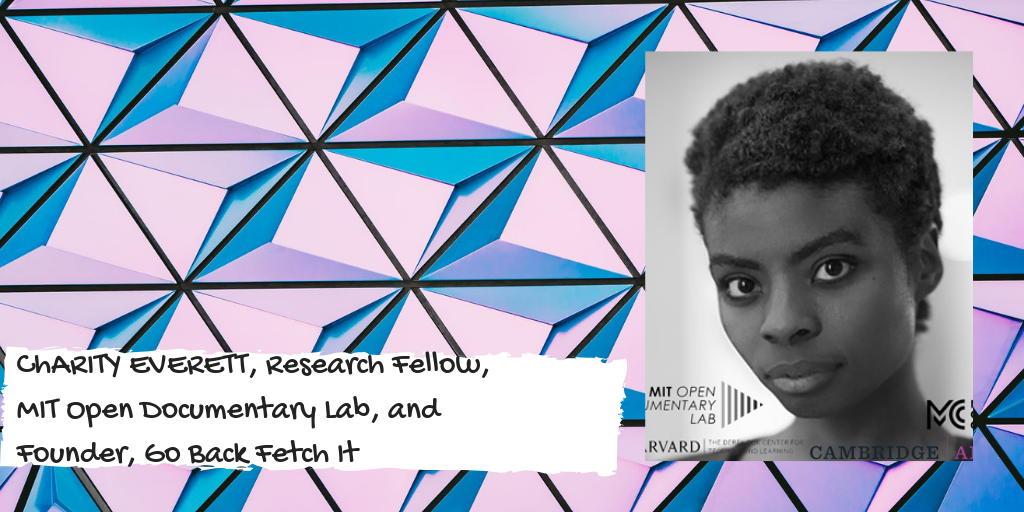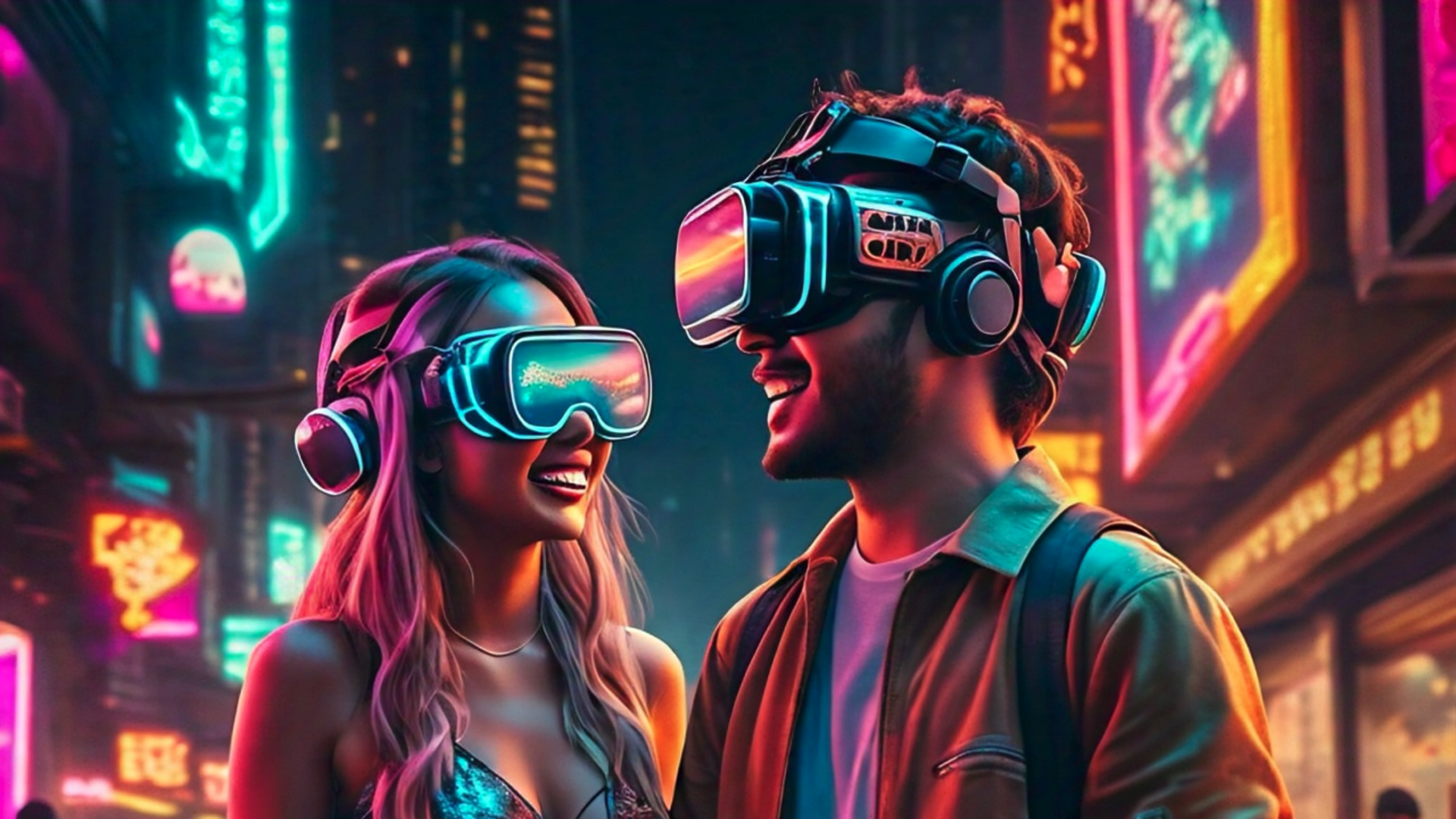When it comes to achieving gender equality, the technology industry is behind the U.S. economy as a whole. Women are paid less, receive less VC funding, and occupy fewer leadership and technical positions compared to men. So, for this Women's History Month, I am interviewing real women working in immersive tech, women who challenge the idea that the tech industry lacks visible female role models. Enjoy!
Charity Everett, Research Fellow, MIT Open Documentary Lab
Emily: To begin, could you provide us with a little background on yourself and your career?
Charity: I am the founder of Go Back Fetch It, and I'm using XR storytelling and art to connect dots across time and collapse time for the betterment of humanity. I am also a Fellow at the Open Documentary Lab at MIT, and at the Derek Bok Center for Teaching and Learning at Harvard University on the Reality Labs team.
Emily: Wow, that sounds really impressive and ambitious!
Charity: Yeah, definitely. It has been called ambitious on more than one occasion, and I think the main thing about it is the fact that I'm really focusing on collaborating with people who have projects that are so arresting and show how all things are connected. And I'm doing it through a centralized storyline of a character named Eve who is going on this heroine's journey through the different phases of the human story; and then using data storytelling and data visualization as a mechanism through which to collapse and move through time and serve as a portal into the worlds of other people's interactive works, documentaries, and information repositories. The first documentary that I'm dealing with is a Brazilian documentary called "Espero tua (Re)volta" by Eliza Capai that just won the International Amnesty and Peace Awards at the Berlinale Film Festival.
Emily: Are you using AR/VR as the medium to connect all these different disciplines?
Charity: Yeah, I'm connecting disciplines and dots. I'm mixing physical art pieces, storytelling, music, XR (crossing the barrier from AR to VR), and also data storytelling as a way to move through time and from there create an actual portal into worlds of different people doing different things around storytelling, interactive documentary, shining light on different aspects of humanity than are normally presented. This all has the aim of challenging people's subconscious, preconceived notions on as many layers as possible, beginning with a fundamental one: Who is a protagonist?
Emily: Is this something you don't think would have been possible before XR arrived?
Charity: Absolutely. There's no way you could effectively collapse time and space like this before, because there are so many elements that would only work effectively in spatial computing. Trying to do things in a three-dimensional space on a two-dimensional screen has its limitations, and as far as being able to effect long-term change there is something that comes from actually being immersed in an environment--a new way of looking at things and a new way of experiencing things that can actually change the wiring of your brain and allow fundamental shifts to happen.
Emily: What is it like as a woman working in AR/VR?
Charity: I haven't found any particular barriers by being a woman. I feel very inspired because everywhere I look I see women doing amazing things in this space. I feel like we're absolutely everywhere. From the very beginning, I've seen amazing women like Nonny de la Peña. I'm a fellow at the MIT Open Documentary Lab and our director Sarah Wolozin is a woman and some of the most amazing things being done in that lab are by women like Sandra Rodriguez, Rashin Fahandej, Ashley Bacchus-Clark and her work with Neurospeculative AfroFeminism. I don't feel like it's been a hindrance in any way.
Emily: What about the user experience for women? I recently wrote an article about how physiological differences between men and women should be more of a factor in hardware design. What do you think?
Charity: Yeah, and I think another thing that needs to be taken into account is hair, and different kinds of hair. For instance, if you're somebody who has hair that's poofier or larger and people are designing these headsets for somebody who doesn't have much hair or whose hair lays flat on their head, that can be a huge hindrance to getting someone to actually put on a headset and try something.
Emily: What is the most critical issue for women in AR/VR?
Charity: Amplifying and supporting one another. Again, I've met so many women doing this. I know there was that scandal at UploadVR, and I feel like this is something that happens in all industries but I try not to focus on the bad apples. There are enough good people out there who are genuinely interested in doing things on the up-and-up and making the world better, that you can choose not to navigate in certain circles.
Emily: Perhaps it is easier for women in XR than in other areas of Silicon Valley, especially with women like Nonny de la Peña being one of the firsts in terms of storytelling and journalism in AR/VR?
Charity: Yeah, and I feel like from the very beginning women did a lot to make sure we were amplifying each other and to get ourselves in there. I feel like I see nothing but amazing women. I mean the head of New Frontier at Sundance is Kamal Sinclair, and she is low-key responsible for this VR revolution we're having. There are so many amazing women in these positions doing amazing things to help one another. Going into this space with the mindset of being mistreated because you're a woman can be very detrimental.
Emily: Do you believe there is a lack of content for women AR/VR users?
Charity: If you step away from strict gaming, which isn't to say women aren't into gaming, there are so many interesting things being done with AR/VR storytelling that would appeal to many types of people.
Emily: What is your advice to women working in AR/VR?
Charity: Everything is about relationships and connections, and not in the sense of trying to get something out of someone. Just connect with people and you'll find others on the same wavelength and together support one another as you continue to grow in this industry and take on the world, but it's all about actually connecting with people.
Emily: What would you like to say to men in the space? What should they be doing to help women in tech?
Charity: I think amplification is the most important thing. There are a lot of tech writers out there who are kind of operating inside an echo chamber, but that being said, I've had great experiences and opportunities being a part of things like the Women in XR Facebook group. For men, put yourselves in situations to be exposed to a greater range of ideas than you might normally, and just listen to, support and amplify women. Oh, and if you're in the position to do so, take out your checkbook.
Emily: What is your greatest hope for the future of AR/VR?
Charity: My greatest hope is that the technology can be used to actually connect us to one another, bring us closer and make us realize that there are no differences between us; we're all one human family, so really using this technology to reinforce our shared humanity. (Emily: Is that the main goal of your current project?) Absolutely, and the work that I'm doing in both my fellowships at the MIT Open Doc Lab and Harvard Center for Teaching and Learning, where I'm helping undergraduates to create with XR technology.
*Charity is one of the esteemed speakers at the 10th annual AWE USA.



